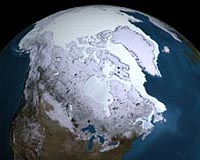| . |  |
. |
Washington DC (SPX) Jan 06, 2010 Scientists documented evidence that the Arctic Ocean and Nordic Seas were too warm to support summer sea ice during the mid-Pliocene warm period (3.3 to 3 million years ago). This period is characterized by warm temperatures similar to those projected for the end of this century, and is used as an analog to understand future conditions. The U.S. Geological Survey found that summer sea-surface temperatures in the Arctic were between 10 to 18C (50 to 64F) during the mid-Pliocene, while current temperatures are around or below 0C (32F). Examining past climate conditions allows for a true understanding of how Earth's climate system really functions. USGS research on the mid-Pliocene is the most comprehensive global reconstruction for any warm period. This will help refine climate models, which currently underestimate the rate of sea ice loss in the Arctic. Loss of sea ice could have varied and extensive consequences, such as contributions to continued Arctic warming, accelerated coastal erosion due to increased wave activity, impacts to large predators (polar bears and seals) that depend on sea ice cover, intensified mid-latitude storm tracks and increased winter precipitation in western and southern Europe, and less rainfall in the American west. "In looking back 3 million years, we see a very different pattern of heat distribution than today with much warmer waters in the high latitudes," said USGS scientist Marci Robinson. "The lack of summer sea ice during the mid-Pliocene suggests that the record-setting melting of Arctic sea ice over the past few years could be an early warning of more significant changes to come." Global average surface temperatures during the mid-Pliocene were about 3C (5.5F) greater than today and within the range projected for the 21st century by the Intergovernmental Panel on Climate Change. Scientists studied conditions during the mid-Pliocene by analyzing fossils dated back to this time period. The USGS led this research through the Pliocene Research, Interpretation and Synoptic Mapping group. The primary collaborators in PRISM are Columbia University, Brown University, University of Leeds, University of Bristol, the British Geological Survey and the British Antarctic Survey. Learn more about PRISM research.
Share This Article With Planet Earth
Related Links More about stratigraphy Beyond the Ice Age
 Canada announces Arctic conservation study
Canada announces Arctic conservation studyOttawa (AFP) Dec 8, 2009 Canada's environment minister on Tuesday announced a five-million-dollar (4.7 million US) feasibility study for the creation of an Arctic marine conservation area at mouth of the famed Northwest Passage. "As global climate change continues and traffic through the Northwest Passage is expected to increase, our government is committed to safeguarding Canada's Arctic and protecting its most ... read more |
|
| The content herein, unless otherwise known to be public domain, are Copyright 1995-2009 - SpaceDaily. AFP and UPI Wire Stories are copyright Agence France-Presse and United Press International. ESA Portal Reports are copyright European Space Agency. All NASA sourced material is public domain. Additional copyrights may apply in whole or part to other bona fide parties. Advertising does not imply endorsement,agreement or approval of any opinions, statements or information provided by SpaceDaily on any Web page published or hosted by SpaceDaily. Privacy Statement |